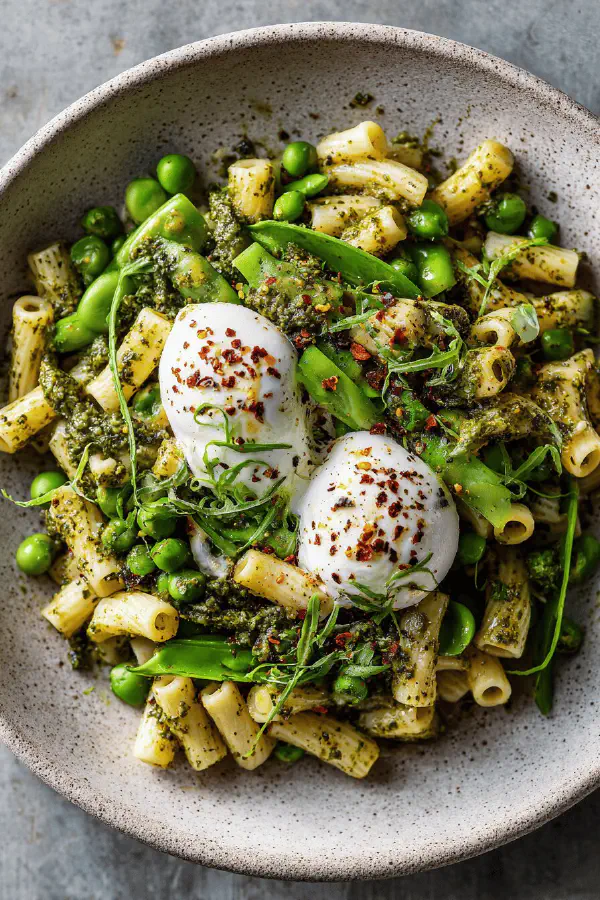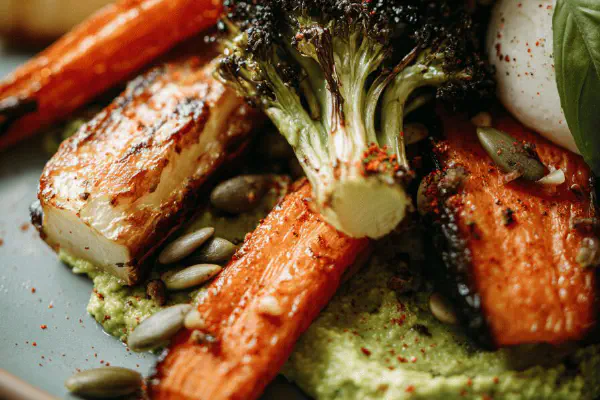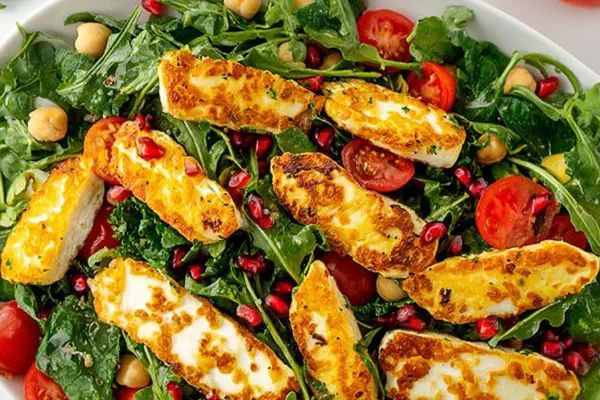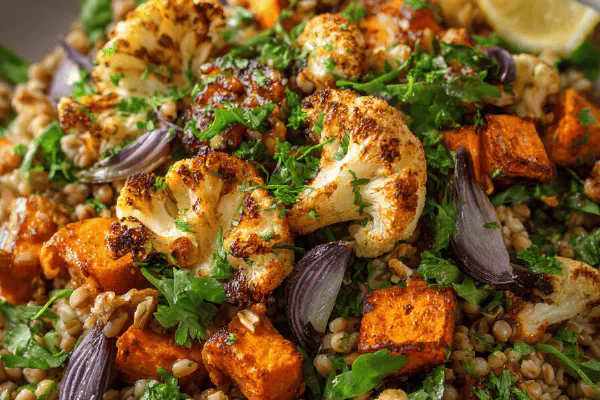Featured Recipe
Pasta Salad with Pesto Burrata

By Kate
"
Pasta tossed with a vibrant herb and olive pesto, green peas, snap peas, and creamy burrata. The pesto swaps olives for capers and lemon zest to brighten the herbal punch. Quick blanching locks pea sugars and color. Small tubular pasta holds sauce well. Burrata split whole crowns the dish, its creamy center breaking over warm pasta. Finished with chili flakes, flaky sea salt, drizzled oil. Chilled then briefly brought back to room temp to release aromatics and textures. Versatile, vegetarian, gluten-free, nut-free. Straightforward yet nuanced balance of bright, creamy, salty, spicy, fresh.
"
Prep:
15 min
Cook:
15 min
Total:
30 min
Serves:
4 servings
Mediterranean
vegetarian
gluten-free
salad
Introduction
Forget long cooking times or complicated flavors. Bright green herbs and peas with creamy cheese — simple but everything hinges on timing and technique. Blanch peas right: boiling water, quick bath, ice cold water to stop cooking instantly, holds vibrant color and snap. Pasta drained al dente retains tooth and absorbs pesto flavor but avoid mush. Burrata serves whole, soft but intact, creamy core waiting to ooze. Pesto swapped olives for capers and added lemon zest — salt balanced not to overwhelm. Rest chilled to marry flavors yet serve nearly room temp, where aroma lifts and texture sings. Small tweaks level up the simplicity. Here if you know your basics, you nail it clean and fast.
Ingredients
Pesto
- 70 g (2 1/2 cups) fresh basil leaves, lightly packed plus extra for garnish
- 40 g (3 tbsp) salted capers, roughly chopped
- 25 g (1/4 cup) grated aged pecorino cheese
- 1 garlic clove, minced
- 2 tsp finely grated lemon zest plus 15 ml (1 tbsp) lemon juice
- 1 pinch crushed red pepper flakes
- 80 ml (1/3 cup) extra-virgin olive oil plus more for serving
- Salt, to taste
- 130 g (3/4 cup) frozen green peas
- 120 g (1 1/4 cup) snap peas, trimmed and sliced crosswise
- 350 g (3/4 lb) small tubular pasta, e.g. ditalini or small shells
- 1 burrata ball, about 220 g, room temperature
- 1/2 tsp crushed red pepper flakes plus extra to garnish
- Flaky sea salt, to taste
Salad
About the ingredients
Swap olives from pesto if you want less oiliness and bright punch — capers bring salty acidity. Pecorino cheese sharper than parmesan but parmesan or aged asiago will do equally well. Basil vibrant and fresh—turkey hawk leaves dry quickly, pick younger ones with deep green and tender stems. Frozen peas hold better texture than fresh outside spring season, but fresh acceptable if newly shelled and blanched rapidly. Snap peas add crunch and visual brightness but green beans blanched just shy of soft also work. Burrata tender, best at room temperature to soften the cream inside, store tightly wrapped to avoid moisture loss. Olive oil quality makes difference here—it’s for finishing, not cheap stuff. Salt pasta water generously, it seasons pasta from inside out—common mistake to skimp, leads to bland base.
Method
Prepare Pesto
- Pulse basil, capers, pecorino, and garlic in a food processor until finely chopped. Add lemon zest, juice, and red pepper flakes. Stream in olive oil slowly, blending until creamy but grainy. Scrape sides often. Adjust salt — capers add saltiness but balance carefully. Keeps up to 5 days if covered lightly with oil and refrigerated.
- Boil heavily salted water. Drop green peas and snap peas, cook until bright green and tender-crisp, about 1 1/2 to 2 minutes. Drain with slotted spoon and plunge into ice water immediately to stop cooking. This locks vibrant green color and snap texture. Drain well.
- Use same water — it’s already salted and hot. Cook pasta al dente: tender but firm to bite, about 8-9 minutes depending on shape. Drain quickly. Retain a little pasta water in case sauce needs loosening.
- Combine pasta with peas in a large bowl, immediately add pesto and toss gently but thoroughly. Pesto clings best when pasta is still slightly warm, but not hot enough to wilt basil or melt cheese in sauce. Adjust seasoning—if it tastes flat, a splash of lemon or salt can wake it up. Chill at least 45 minutes to 1 hour; resting helps flavors marry and sauce to thicken slightly.
- Just before plating, toss salad again to redistribute sauce and loosen if dry with reserved pasta water or a drizzle of olive oil. Divide between plates. Tear burrata in half and place centrally on pasta, not scooped. The creamy center will ooze naturally when broken at the table. Sprinkle with more chili flakes and flaky sea salt. Spoon over a little drizzle of olive oil and scatter basil leaves for fragrance and color.
- Capers in pesto bring salty brine, swap olives for brightness and a twist. Pecorino provides a sharper bite; can substitute with parmesan or aged asiago. Burrata can be replaced by fresh mozzarella but loses that luscious creamy core. Snap peas can be swapped for blanched asparagus or green beans in season. If no food processor, finely chop and mix ingredients by hand, slower but manageable. Use plenty of salt in pasta water to season pasta deeply; under-seasoned pasta kills flavor. Always shock peas to preserve green. Rest salad to avoid clumpy cold pesto. This salad travels well; pack burrata separately if needed.
Cook Vegetables
Prepare Pasta
Assemble Salad
Serve
Tips & Substitutions
Technique Tips
Pesto done in food processor saves time but keep an eye on texture—grind too fine, loses personality; too chunky, poor sauce adhesion. Oil added slowly to emulsify. Salting pesto carefully; remember capers add salt, taste before correcting. Blanch veggies in boiling salted water just long enough for vibrant color and snap, drain immediately, plunge into ice water to stop cooking—standard blanching trick to preserve color and texture. Cook pasta in same water to save time and washing up—don’t overcook, al dente with a slight resistance and no chalky core. Toss pasta and peas with pesto while pasta still a bit warm for better flavor adhesion, then chill for flavor meld. Before serving, toss gently to loosen pesto—can add drip of pasta water or olive oil if sauce too stiff. Burrata cut in halves placed on top, never mixed in, to keep texture contrast visually clear and textural drama intact. Sprinkle chili flakes and fleur de sel last for crunch and heat—balance spice with creamy burrata richness. Serve at room temperature for best flavor release, too cold masks aromas.
Chef's Notes
- 💡 Nail pesto texture in food processor. Too fine, loses character; too chunky, sauce won't cling. Watch those basil leaves. Blend till grainy.
- 💡 For vibrant peas, boil water, salted well. Plunge snap peas quickly then ice bath. Stops cooking fast. It'll keep that crisp pop.
- 💡 Cook pasta al dente. Use same salty water. Don't let it get mushy. Aim for firmness; it absorbs pesto deep. Retain pasta water.
- 💡 Chill salad to meld flavors, but serve near room temp. Fresh herbs and the soft center of burrata shine at warmer temp. Release aroma.
- 💡 Top with chili flakes and flaky salt. Last splash of olive oil for finishing touch. Visual and textural contrast is key with burrata.
Kitchen Wisdom
What's the best way to keep this salad?
Store in airtight container fridge. Dressing avoids soggy pasta.
Can I change ingredients in the salad?
Yes, swap snap peas for blanched asparagus or green beans. Fresh herbs too.
What if my pesto is too thick?
Add pasta water slowly to loosen. Stir till velvety again. Emulsifying is vital.
How to store leftover pesto?
Cover in oil, refrigerate. Lasts up to 5 days. Freeze in ice cube trays for longer use.



